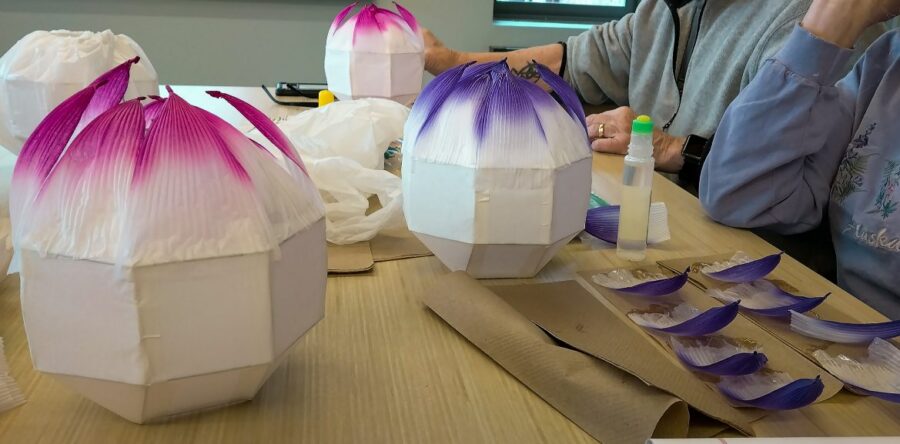by Audrey Anderson
Hometown Weekly Reporter
Recently, the Sherborn Library held a fun Lotus Lantern Workshop. The workshop was led via the Internet by Younhee Shin from the New York City office of the Korean Spirit and Culture Promotion Project. Local participants could choose to participate in person at the library or through Zoom from home.
Shin began the workshop by sharing information about her organization. The Korean Spirit and Culture Promotion Project is a worldwide organization run by volunteers in several countries, including the U.S., Australia, Canada, Italy, Germany, and the UK. In the U.S., the project has presented 2,600 events that were attended by 1,000,000 people.
Next, Shin focused on the significance of the lotus flower in Buddhism. The root of the lotus flower lies in the mud, the stem rises through the water, and the flower is above the water, in the sunlight. For Buddhists, the lotus flower represents rebirth, self-purification, and spirituality, and it is the symbol of Buddhism itself. The color of the lotus petals represents different qualities, for example:
white-spiritual perfection and mental purity;
pink-supreme color for the Buddha himself;
blue-serenity and peace;
purple-self-awakening, harmony, and balance.
On Yeondeunghoe, or Buddha’s birthday, a lantern festival, is held at Buddhist Temples throughout South Korea. Shin showed photos of the lantern festival and the parade held in Seoul, which included brightly lit dragons, lighted towers, people carrying lanterns, and lanterns decorating temples.
After presenting the significance of the lotus flower and lanterns in South Korea, Shin expertly led the participants in creating their own lotus lanterns. Each participant, whether in person or on Zoom, was given a kit containing a lantern frame made of wire and paper, a package of petals and leaves made of a thin paper, and glue. After everyone unpacked the kit, Shin explained how to prepare the petals by brushing the bottom white part with glue and then sticking them to the lantern frame in a specific pattern. This was done in five stages to cover the frame. Participants laughed and chatted as they worked on their lanterns, wiped glue off their fingers, and watched the lanterns come to life. Everyone seemed to be quite pleased with the results of their labors.
As the glue dried, Shin offered some information on the history of Korea and Seoul’s evolution into the current world-class city it is today.
In its colonial period, Japan conquered Korea and worked to assimilate its people into the Japanese culture. The people were forced into unpaid labor.
Seventy years ago, in the Korean War, 80% of the South Korean infrastructure was leveled. South Korea was the poorest country in the world, and its people struggled to survive. By 1997, South Korea was bankrupt.
Women and men donated their gold jewelry and objects to the government, even though they themselves were in need. People worked together for the good of all. The government used the donated gold and other sacrifices of its people to work itself out of massive debt.
Impressively, the South Korea of today is thriving. The country’s population is 50,000,000. The average life expectancy in South Korea is 82.7 years, one of the highest in the world. The infant mortality is one of the lowest in the world. Health care costs are among the lowest in the world. The crime rate is below the world average. South Korea has hosted 4 of the major athletic games in the world, and it is a major destination for business meetings and tourists.
At this point in the workshop, the glue was dry enough to move the lanterns, and Shin bowed and said goodbye to all. Participants were happy to have learned about the symbol of the lotus in Buddhism and to have received an update on the state of South Korea. They were also thrilled to have created colorful lotus lanterns to grace their homes.






















